30 Years in the Making: The Journey of the NAU Early Learning and Development Center
Arizona Association for the Education of young Children, Jo Chavez, April 4, 2023
Adapted from an Interview with Rebecca Cirzan, Director of the NAU Early Learning and Development Center
Dr. Pam Powell, Associate Dean of the NAU College of Education, Rebecca Cirzan, director of the NAU Early Learning and Development Center, and Dr. Tori Damjanovic, NAU Assistant Professor in Early Childhood Education/Special Education attended the ribbon cutting ceremony for the NAU Early Learning and Development Center on March 27, 2023.
A Lab School for Students and the Community
At Northern Arizona University (NAU), supporting early childhood educators and modeling the importance of education has long been a priority. That’s why the concept of developing an early childhood learning center had been explored to varying degrees for nearly 30 years—to serve as both a place for NAU student parents to access quality education for their children and as a learning lab for the university’s College of Education students.
Then in 2021, NAU welcomed a new president, Dr. José Luis Cruz Rivera. Dr. Cruz Rivera has shared his own experiences as a student-parent when he was 19 years old. In his remarks at the recent grand opening of the NAU Early Learning and Development Center (ELDC), Dr. Cruz Rivera recalled times when it was difficult for him juggling costs and responsibilities. At one point, he even considered dropping out of college because the cost of child care was getting too high. But ultimately, he decided to stick it out and finish his education.
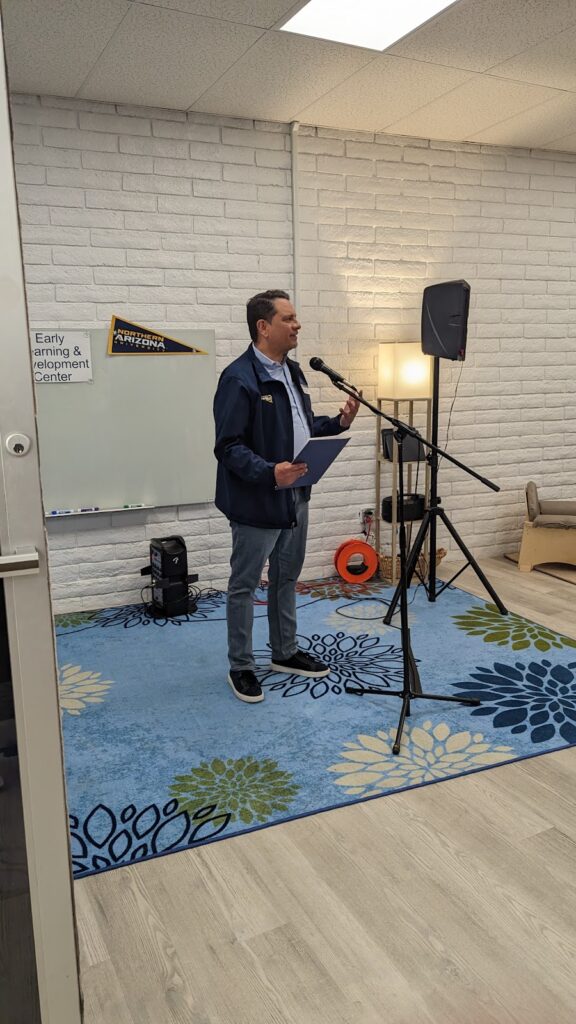
NAU President Dr. José Luis Cruz Rivera speaks at the ribbon cutting ceremony.
When Dr. Cruz Rivera heard about the concept for an on-site early learning center at NAU, he was not only onboard to make it happen, but he gave his support to make it happen fast.
“Dr. Cruz Rivera recognizes the benefit of what an early learning center can mean for students because he knows what it would have meant for him as a student,” says Rebecca Cirzan, director of NAU’s ELDC. “By providing stability and showing that we are committed to all parts of our students’ lives, we ensure they can be successful in their college careers.”
The ribbon cutting ceremony, held at the end of March 2023, marked this 30-year dream realized with the opening of the ELDC.
Values of the Program
The ELDC is designed to serve children of NAU students, faculty, staff and community members, with an environment that supports children holistically through a strengths-based lens. Cirzan says the ELDC will engage in reciprocal relationships with families in order to connect their knowledge with the pedagogy of early childhood education.
The vision for the Center is to, “exemplify an inquiry approach to teaching and learning, improving inclusive early childhood pedagogy through education, research, and community engagement.”
The inquiry-approach is child-centric, says Cirzan. “It views children and families as collaborators in the development of lessons and curriculum.”
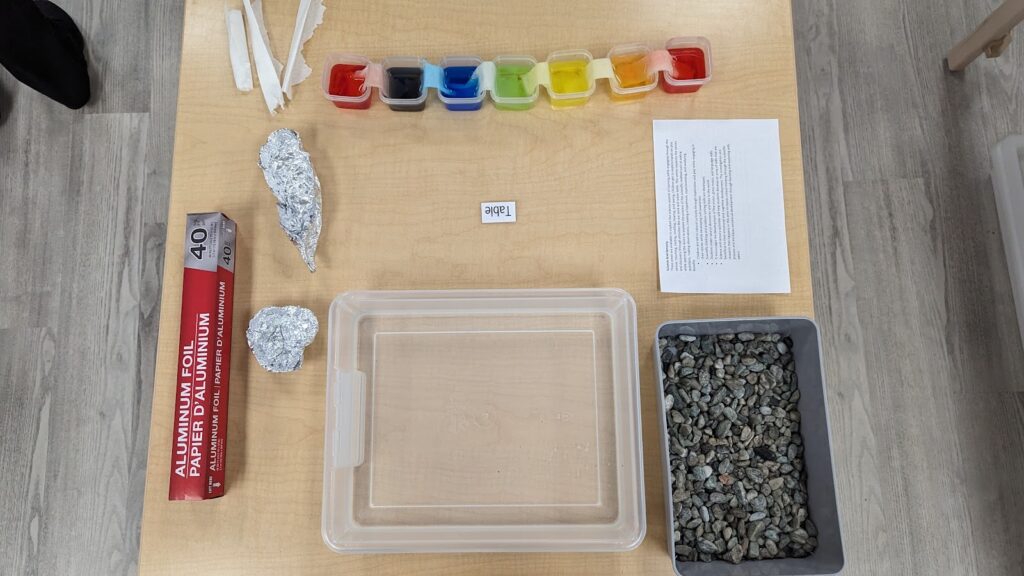
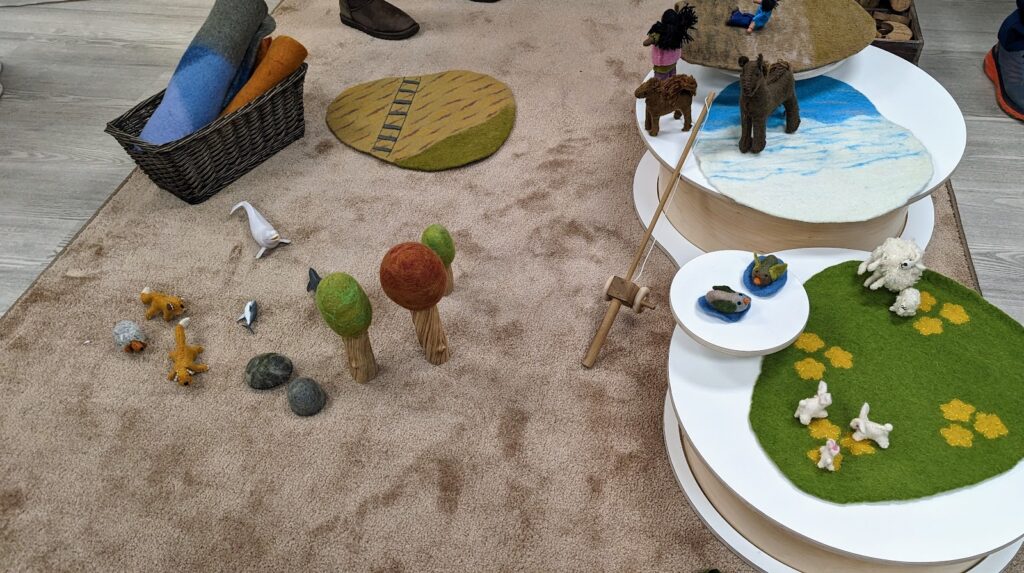
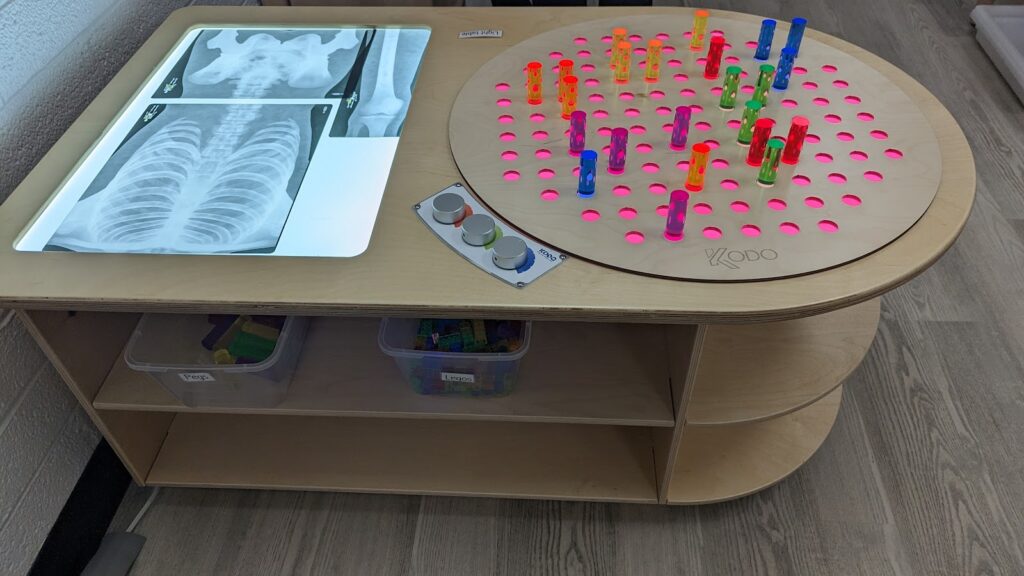
The NAU Early Learning and Development Center will focus on inquiry-based learning, supporting children to explore the world around them and their relationships within it.
Specifically, the Center’s philosophy states:
- Children are viewed from an asset-based lens, and curricular design will highlight the unique abilities of each child.
- Through inquiry-based learning, children will explore the world around them and their role in it.
- All children are valued as individuals, and the unique perspectives, and experiences of all children and families in the program are celebrated.
Cirzan says because NAU seeks to be a lab school, the ELDC will extend knowledge and further cultivate early childhood practices by providing opportunities for students, teachers, and faculty to engage in research within an early learning context.
“We will be able to try out different things and collect data and information on what’s working for young children in the learning environment,” says Cirzan. “We will accept selective research proposals from within the university that may be a good fit for our program and implement some of those practices that benefit our children.”
Another important focus for the ELDC is diversity. “We want to make sure that we’re including and celebrating Hispanic and Native American voices within our program,” says Cirzan.
NAU is a U.S. Department of Education designated Hispanic-Serving Institution, which means the university has an enrollment of undergraduate full-time equivalent students of at least 25% Hispanic students. Cirzan says NAU recently received a grant to pursue the designation of being a Native American Serving Non-Tribal Institution, which recognizes institutions of higher education with an enrollment of undergraduates that is not less than 10% Native American students.
“We want to serve the populations that traditionally have been underserved in our community,” says Cirzan. “Our goal is to work with families to ensure that we are being inclusive of different races, cultures and backgrounds. We want to be mindful about implementing various traditions in our classrooms. We’ll also make sure we’re looking at anti-bias commitments and statements. This will be a continuous cycle of making sure that we are equitably representing all populations.”
About the Program
The ELDC is opening in a space leased from Flagstaff Unified School District and will begin with one classroom for 25 children, ages 3-5.
Cirzan explains that the classroom will have two mentor teachers with each serving one-half of the students. “The teachers will have plenty of time to interact with each other during investigation time in the classroom, which is part of the project approach,” she says. “During this time, children will have the freedom to have meaningful experiences with materials and the environment that are relevant and interesting to them. The teachers help support the children and move them into a discovery mindset.”
Cirzan compares the ELDC approach to the Reggio Emilia Approach in that it’s focused on quality relationships and inquiry-based experiences for children. “The project-based approaches will allow us to really focus on what children are interested in. Teachers will ask children questions about what they might want to learn, they’ll observe, and then provide authentic experiences for children to learn more about those topics that most interest them.
“The beauty of the Project-Based Approach is that you can involve the community in a very natural way in your program. As children become interested in certain topics, you can bring in those community experts and those real life artifacts into the classroom so children have the opportunity to learn more firsthand.”
Cirzan explains an example could be children being really interested in watching cars come in and out of the parking lot. “They are asking questions about how the cars can be driven in the snow and what’s happening when the cars slide on the snow. So, as teachers, we ask the children about what they see and we might start by asking them to draw pictures of what they see the cars doing. We would have dialogue about the cars and the children’s observations. From here, we keep expanding on things children may want to know more about. What makes the tires able to drive on the snow? Who clears the snow? There are vehicles that pound little bumps in the snow so it’s graded, so what’s that about? You start to develop your curriculum based on ideas children have in asking and answering these questions. So, maybe you bring in a regular tire for the students to see up close, or you have someone from city public works come in with a snow plow so the students can ask questions. Then you may have the children draw pictures of how snow plow tires compare to regular tires.”
Throughout this process, teachers act as a guide. “One of my favorite parts of the Project-Based Approach is that it offers an opportunity for children to showcase what they have learned back to their families and communities. They have this culminating event, which the children come up with, to demonstrate what they’ve learned. So you get to show the families the process of, here’s what we first thought about cars and driving, and now here’s what we know now based on all these things we discussed and experienced. It reminds us to pay attention to the questions children are asking knowing you can build their learning on their questions. We need to build on children’s natural curiosity and develop lessons based on that. I’m looking forward to seeing families and educators experience this.”
The ELDC strives to be an inclusive site, especially to serve children with disabilities. Cirzan says they want to model what effective inclusion should look like, so there are pre-enrollment meetings to talk about what behaviors or needs a family sees their child has and what modifications might be most appropriate within the center so those resources can be brought in.
A common need may be speech services, Cirzan says. NAU has a Speech-Language-Hearing Clinic on campus, so the ELDC will be able to leverage those services and bring them into the classrooms. During the summer, the ELDC will bring in the clinic team to conduct hearing and language screenings for all children at the center at no cost. The team will then be able to implement programming for the children that would most benefit from language and communication skills for individual children and the whole class.
Another example is NAU’s Institute for Human Development. “They can provide a comprehensive developmental screening,” Cirzan says. “If we have a child that has some additional needs and we need to find out more information, we’ll be able to leverage the services from the Institute of Human Development. These examples just scratch the surface of services that we can provide. This really sets us up to be inclusive of all children.”
Creating an Exemplary Model for Quality and Supports for Early Childhood Professionals
In order for the ELDC to successfully implement the inquiry-based approach, first and foremost, highly-qualified educators with strong foundational training were needed. Cirzan explains the ELDC has two different types of positions, one is a co-teacher and the other is a mentor teacher. Each classroom will have two mentor teachers and a co-teacher.
A mentor teacher serves as a lead teacher and the facilitator and guide for the inquiry-based learning within the classroom. They also serve as a mentor to practicum student teachers helping to prepare the next generation of educators.
“Mentor teachers have master’s degrees in early childhood education or early childhood special education. They come with ample experience in the field and are able to implement child-centered learning.”
Co-teachers are a partner to mentor teachers. They have prep time every day to document children’s learnings and share their observations and help build lessons based on observations.
“All of our teachers are full-time and have competitive salaries and benefits that are better than their K-12 counterparts. These are all 12-month positions because we know that families and children and families need that continuity of care. There are very few options for children under the age of five over the summer months.
“It’s also important for our model that teachers have paid planning time every day. So, not only do they get their usual lunch break, but they also get preparation time every day. On Fridays, the staff then gets time to work together as a collaborative team in the spirit of the inquiry-approach. We want them to collaborate and think about their own practice and learning when they are planning for children.
“We’re building this robust early childhood system by giving practicum, student-teachers, and co-teachers the training and experience in an environment that models how we should treat children and how we should think about children’s learning experiences.”
The ELDC was designed first to serve NAU student-parents. Enrollment is prioritized for that group first. Student-parents can be enrolled part-time or full-time at any level—undergraduate, graduate, or doctoral. NAU was awarded the CCAMPIS Grant, allowing for the ELDC to provide child-tuition assistance to students who qualify. After student-parents, the ELDC serves NAU faculty and staff. After that is the broader community. Launching first with a preschool classroom, plans for a toddler classroom are underway as Cirzan says toddlers are a highly underserved age group in the area.
The ELDC will also soon begin the process of seeking Early Learning Program Accreditation from the National Association for the Education of Young Children (NAEYC).
Looking ahead, Cirzan says creating an exemplary model of early childhood education is not the end of what the ELDC wants to do. “We want this center to become a professional development site for other early childhood educators. This can be a community resource and a lab for early childhood education majors or for current early childhood center directors as well. We want it to be a community hub for families so that we have comprehensive resource coordination within our facility. So, we are looking at how we can bridge NAU resources with community resources so that anyone can come in and find out about the early childhood community and get the services and resources they need as a family.”
Future aspirations include having the ELDC located on the NAU campus so that it is easily accessible for those it’s designed to serve. “We may also consider how it ties into family housing. Opening the ELDC is a significant first step, but it’s not the only step we are taking moving forward.”
As the ELDC begins welcoming students and families, Cirzan says she hopes to send a message.
“I want the NAU community, whether it’s a student, faculty or staff member, to see what early childhood education can and should be about. Many of us have an image in our minds of how we used to care for children either from our own upbringing or our own school experience. I want people to get out of their comfort zone and stop thinking that early childhood education is just about pre-academic skills. I want them to see what a beautiful thing it is to have an environment that truly respects children and honors their process of learning. For the broader community, I want them to be excited when they see this work so that they start demanding higher quality care for all children.”
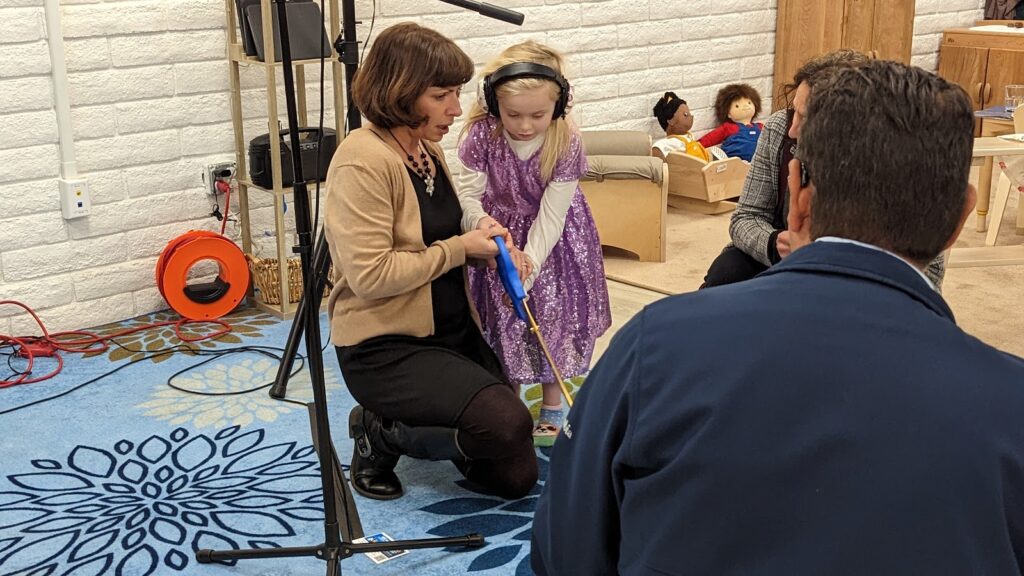
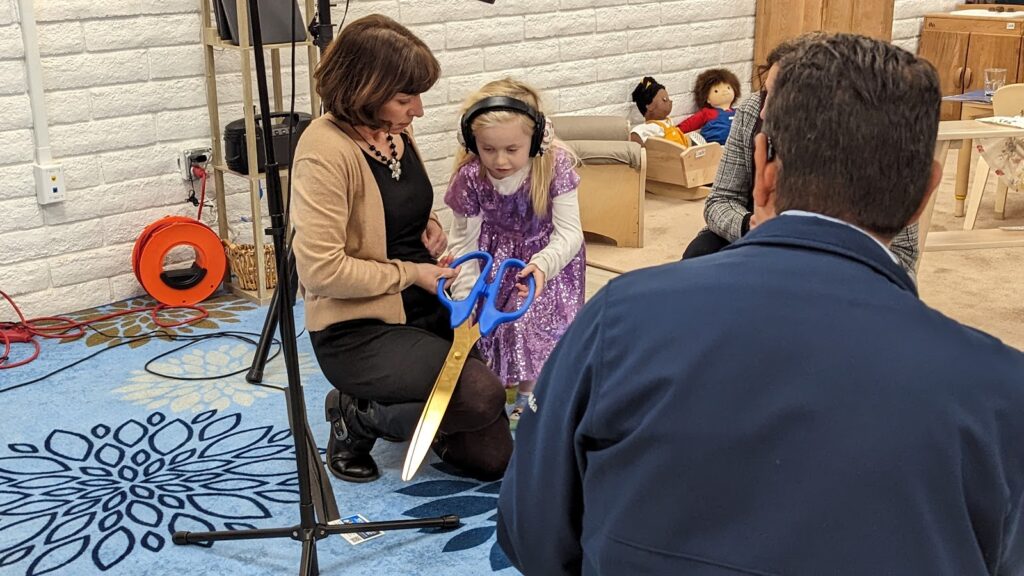
A preschooler who will be attending the NAU Early Learning and Development Center helps cut the ribbon with Center Director Rebecca Cirzan.
About the Author
Rebecca Cirzan (she, her, hers) is the Director of the Early Learning and Development Center at Northern Arizona University in Flagstaff, Arizona. Cirzan has worked in the field of early childhood education for more than 13 years including working as a teacher, director, coach, mentor, and professional development specialist in both schools and non-profit settings.
